Full Servings
Through the research and development of new crop varieties, the LSU AgCenter shapes agriculture in Louisiana and, in some instances, the world.
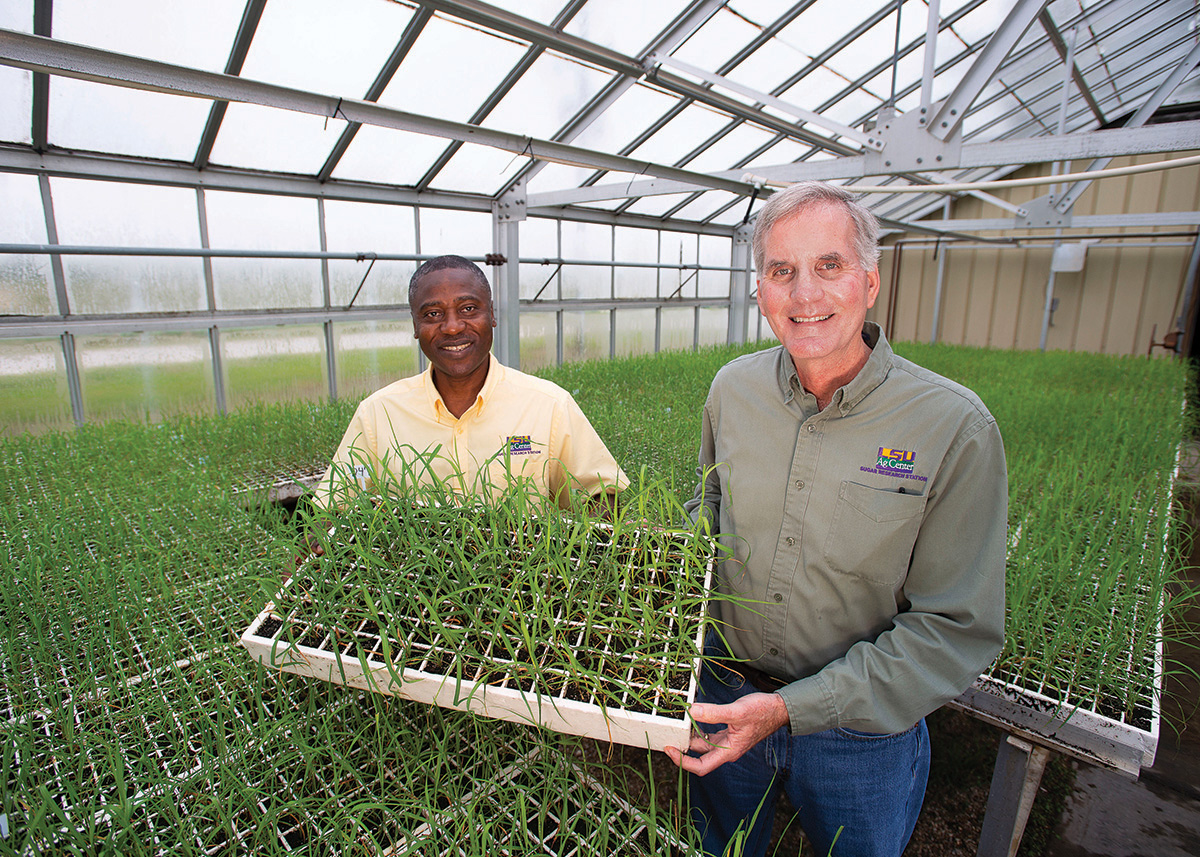
In breeding new sugarcane varieties for Louisiana farmers, Collins Kimbeng and Kenneth
Gravois work against threats they don’t even know exist yet. LSU AgCenter-developed
varieties of sugarcane had a $1.2 billion economic impact for Louisiana in 2019.
LSU AgCenter
The three crops where LSU AgCenter innovations have had the largest impact are sugarcane,
rice, and sweet potatoes. Seven out of every ten Louisiana fields of sugarcane and
rice are cultivated with LSU AgCenter varieties (around 70%). For sweet potatoes,
it’s practically ten out of ten (at least 98%).
Each year, the university invests in the development of experimental varieties by
identifying and testing new options for farmers. Some traits developers are looking
for have specific and well-known benefits—disease resistance, protection against certain
herbicides or pesticides, and overall great yield.
Sugarcane
“Telltale signs for successful sugarcane traits are high-tonnage cane and high sugar
content, which means lots of cane and lots of sugar in that cane,” James H. Simon,
head of the American Sugar Cane League that represents growers and millers, said.
“But getting there is a challenge. You’ve got pests and weeds and other competitive
factors that limit those traits from expressing themselves. Often, you don’t know
what will happen. You might start out with almost 100,000 potential new varieties,
but ultimately, twelve to fifteen years later, you’re fortunate if you have one or
two that come out. This is why our industry needs research and why we work very closely
with LSU.”
Simon is a frequent visitor to the LSU AgCenter Sugar Research Station in St. Gabriel, Louisiana. He lends a keen eye to the advanced molecular work happening
at the university on genetic markers and the way traits do or don’t carry over from
parents to offspring.
“Same as with people, you can have a sweet dad and a sweet mom but that does not in
any way ensure the child is going to be a sweet child,” Simon said. “Sugar DNA is
very complex, and it’s a big challenge to get traits from parents to express in offspring.
The new scientific techniques LSU uses to identify traits save a lot of time and money
compared to the traditional way of going through selection both physically and visually.”
Collaborations between the sugarcane industry and LSU go back more than a hundred
years. Parts of the LSU system itself have sweet roots—the LSU Department of Chemistry
and the LSU Department of Chemical Engineering both evolved out of the Audubon Sugar
School, which was founded in 1893 to “meet the peculiar demands of the sugar industry,”
as Charles Coates wrote in 1907. Coates was the third faculty member with a Ph.D.
in LSU history, a chemist and expert on sugar, and—incidentally—the first head coach
of the LSU Tigers football team. Coates Hall on LSU’s main campus in Baton Rouge bears
his name. Another building, Stubbs Hall, is named after William Carter Stubbs who
first directed the Louisiana Sugarcane Experiment Station, the forerunner of the Sugar
Research Station operating today in St. Gabriel.
“Research is an insurance policy.”—Kenneth Gravois, state sugarcane specialist and former LSU AgCenter sugarcane breeder
In the 1920s, when the Louisiana sugar industry was nearly decimated because of cane
disease, LSU signed a three-way agreement—still in effect—with the American Sugar
Cane League and the United States Department of Agriculture (USDA) specifically designed
to improve production through research and variety development.
“We had a near disaster, and I think people really saw the need for science to be
able to sustain the industry,” Simon said. “The research on variety development at
LSU became the cornerstone, and we continue to collaborate very closely.”

Mr. Weller and seedling canes under development in the early 1900s. The university has developed more than 75 varieties of sugarcane since 1885, doubled yields for farmers since 1970, and represent 70% of all sugarcane grown in Louisiana.
LSU
As a resident of New Iberia, Louisiana, Simon appreciates how the more than $2 billion
annual impact sugarcane has for the state’s economy stays in the local communities.
“Especially in the small towns in rural Louisiana that really don’t have much else—oil
can provide a tremendous stimulus, but when oil goes bad, the lights can get turned
off pretty quick—sugar is a stabilizing factor in a sometimes very volatile economy,”
Simon said.
He knows from personal experience. His family has been in the sugar business for several
generations in St. James Parish and St. Mary Parish. Simon is also a graduate of LSU.
“Sugar is important from an economic perspective, but also from a cultural perspective—it’s
our heritage,” Simon said. “I like to remind people that sugar is so important there’s
even a football game named in our honor and that’s the Sugar Bowl.”
LSU and the AgCenter have led or partnered in the development of more than 75 varieties
of sugarcane since 1885. Most are grown in Louisiana, although some are popular in
Florida and Texas. Sugarcane varieties are developed specifically for certain climates,
and Louisiana is about as far north as sugarcane can be grown—a tropical plant in
a temperate place. As you move them around the world, varieties don’t always have
good disease or insect resistance, cold tolerance, or ratooning ability—this means
being able to grow another crop from the stubble without having to plant anew.
The most popular variety of sugarcane grown in Louisiana today (56%) is called L 01-299.
That’s “L” for Louisiana because the cross and the selection were both done in Baton
Rouge. It’s the only commercial sugarcane variety in the state that has the Bru1 gene,
which confers resistance to brown rust disease.
Before L 01-299, there was a variety called LCP 85-384 (developed by LSU in collaboration
with the USDA) that dominated the market.
“When I first came back to LSU in 1997, people thought I was crazy to join the breeding
program,” Kenneth Gravois, former LSU AgCenter sugarcane breeder and now a state sugarcane
specialist, said. “This was because my major professor Freddie Martin [who went on
to direct the LSU School of Plant, Environmental & Soil Sciences] had released LCP
85-384 in 1993, a much-heralded variety that had almost 90 percent of the state’s
acreage. But Mother Nature doesn’t roll over and play dead. She’ll find chinks in
the armor and a disease or insect will come along and take it out, so that’s why you
need breeding programs to constantly turn out new varieties.”
“One day,” he predicted, “299 will fall by the wayside and one of the varieties [LSU
AgCenter principal sugarcane breeder] Collins Kimbeng is working on today will take
its place. Any variety has a lifespan, and you have to have a long-term perspective.
Plant breeding programs are long-term investments, and breeders have to work against
threats they don’t even know exist yet. For example, when they started developing
the 384 variety, they didn’t know it would be resistant to sugarcane smut and leaf
scald. So, breeders developed resistance to threats that weren’t even around.”
Varieties such as L 01-299 and LCP 85-384 are part of the reason the total sugarcane
yield per Louisiana acre has doubled in the last 50 years.
“Good traits bring economic value and stability, which is part of the reason our industry
is expanding right now,” Gravois added. “I like to tell people that it’s our job to
keep the dots above the [expected yield] line, but most importantly, we don’t want
the dots going way up and down and then way up again. In this way, research is an
insurance policy.”
Read more:
Agriculture Research Begins with the Sugar Experiment Station in 1885
From Boats to Bytes: Sugarcane Varieties in Louisiana
Living the Dream—Sugarcane Variety L 01-299
Rice
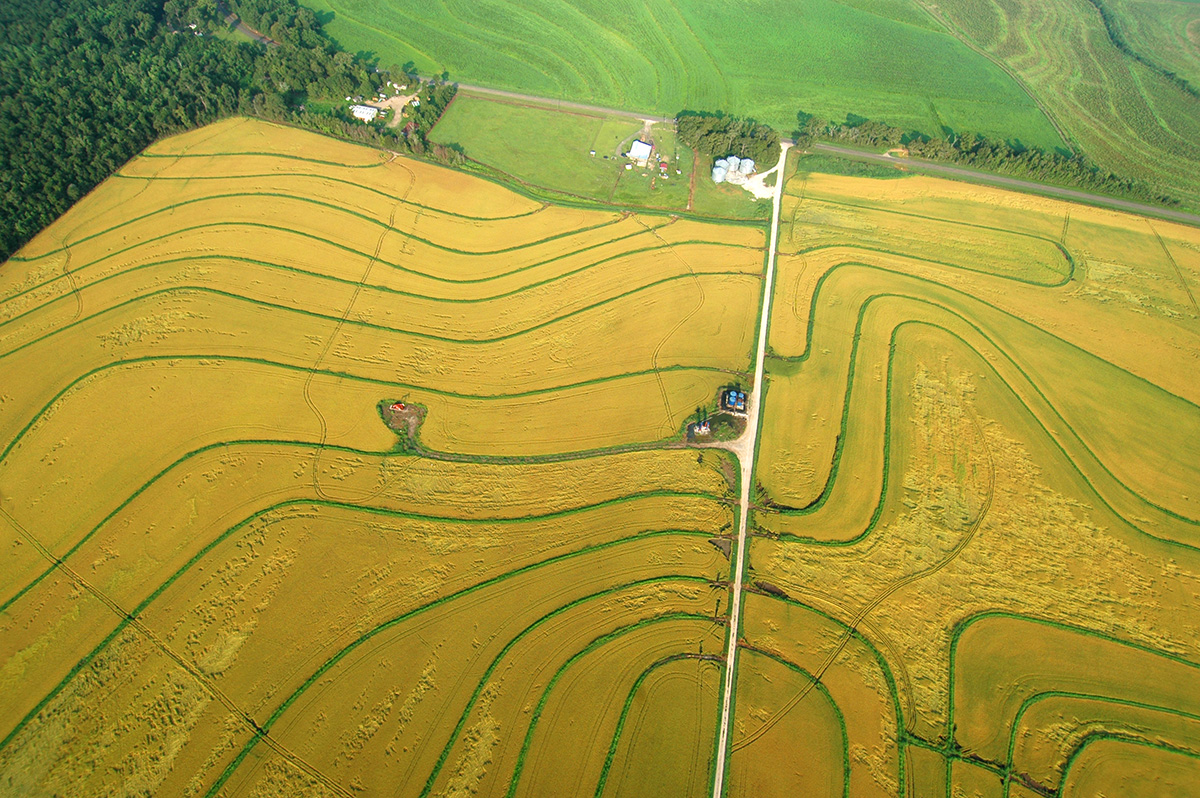
Louisiana rice field; LSU AgCenter-developed varieties of rice had a $384 million economic impact for Louisiana in 2019.
LSU AgCenter
Louisiana rice breeding relies on research and innovation to compete. The LSU AgCenter
has released 57 varieties since 1911 and the start of the breeding program at the
Rice Research Station, which was established in 1909 and is the oldest rice research station in the world,
near Crowley, Louisiana. The reason it was established in that particular spot was
a sign of the times. Although locations in Lake Charles and Jennings were considered,
the railroad had just been completed between New Orleans and Houston, and Crowley
sat right by the railroad tracks. From there, rice could be loaded onto trains and
brought to New Orleans to be milled.
Since the beginning, rice farmers in Louisiana have struggled with various nuisances,
such as weedy rice (also called red rice) creeping in and taking over fields. It wasn’t
until LSU AgCenter developed the Clearfield rice technology and released its first
variety in 2002 that farmers had an effective way to eliminate it. Clearfield rice
was developed from a mutant that is resistant to the herbicide imazethapyr (NewPath),
which kills weedy rice. Various Clearfield varieties now dominate rice fields in Louisiana
and are also grown to a large extent in Texas, Arkansas, Missouri, Mississippi, Florida,
and other places throughout the world.
Meanwhile, farmers have seen instances of Clearfield rice cross-breeding with weedy
rice, lending imazethapyr resistance to the offspring. This has kept researchers on
their toes. In a major collaboration with BASF, the largest chemical producer in the
world, LSU AgCenter now acts as the company’s research and development arm for testing
and breeding Provisia, a new variety farmers can grow on an intermittent basis to
clear their fields of both Clearfield and weedy rice to then be able to start back
up with Clearfield, prolonging the life of the LSU AgCenter-developed superstar technology.
LSU AgCenter’s herbicide-tolerant rice technology contributes up to $95 million in annual management cost savings for rice producers.
An independent study conducted by the University of Arkansas found that LSU AgCenter’s
herbicide-tolerant rice technology contributes up to $95 million in annual management
cost savings for rice producers. Also, by improving the quality of long grain rice
in the southern U.S., the technology has created an estimated economic benefit to
the overall industry, beyond farm management cost savings, in excess of $155 million
since 2009.
But challenges keep coming. Over the past 10 years, LSU AgCenter rice researcher Dustin
Harrell has observed higher disease and insect pressures, in combination with increased
demands from growers for sustainability—to be able to produce more rice with less
resources and adopt new management practices that are better for the environment.
The development of the Clearfield technology has been part of that. Farmers can use
less seed, about 65 pounds per acre instead of 90 to 120 pounds, which saves money.
Clearfield rice can also be dry-seeded, meaning farmers don’t have to flood their
fields immediately and plant pre-germinated rice seed to prevent red rice germination.
This saves water and effort, and lowers the risk of nitrogen runoff into bayous and
rivers, which both saves fertilizer and lightens the agricultural footprint on the
environment.
Rice yield has doubled in Louisiana in the last 50 years. Varieties that grow well
and fast allow farmers time to harvest a second crop each year, using less resources.
“This has become very economically important to rice growers,” Harrell said. “With
the stubble crop, they can increase their yearly yield by about a third. While they
might break even on the main crop, they often make their profit on the second crop.”
Shorter growing cycles also lend some protection against bad weather events. If a
hurricane takes out one harvest, for example, farmers might offset their losses with
another crop. And faster maturing varieties planted in early March can be harvested
just ahead of peak hurricane season, which spans from mid-August until late October.
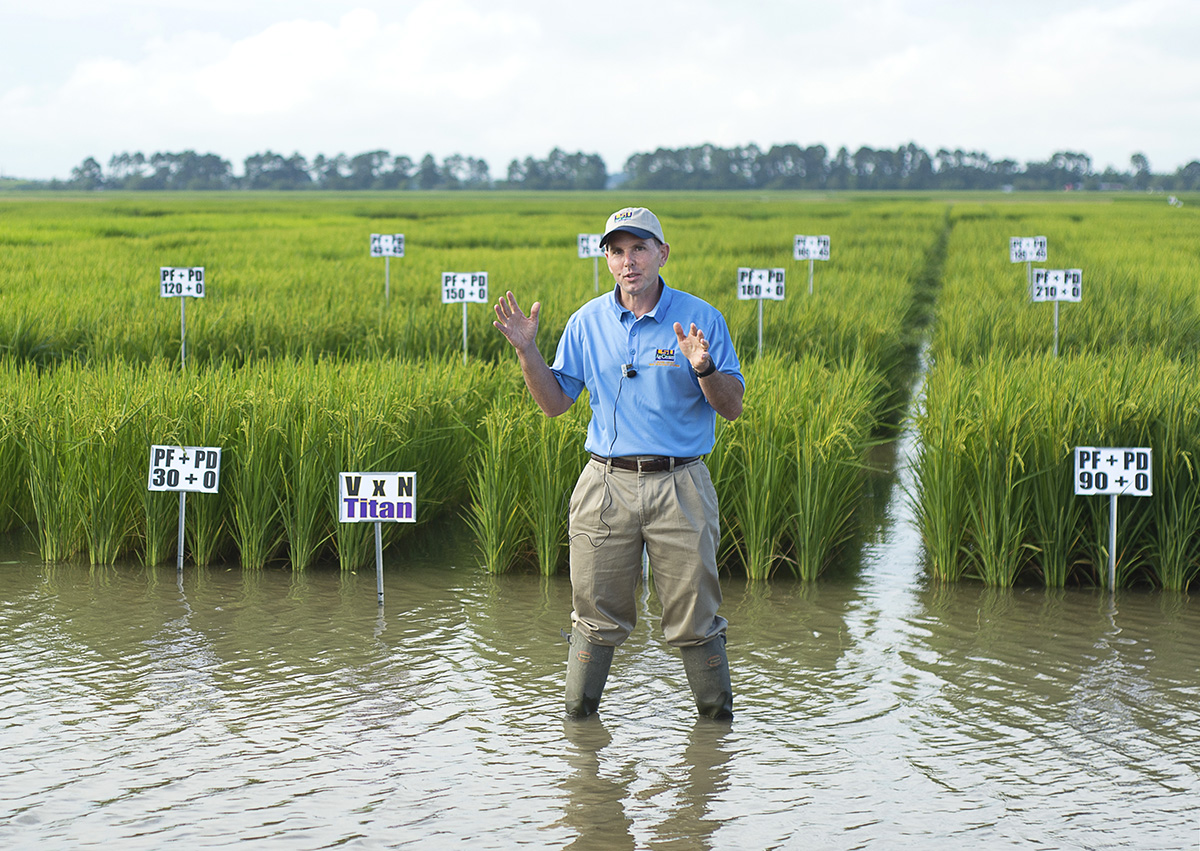
Dustin Harrell stands in a rice field with markers for different nitrogen rates. The university has developed 57 varieties of rice since 1911, doubled yields for farmers since 1970, and represent 70% of all rice grown in Louisiana.
LSU AgCenter
The researchers are performing deep data analysis to improve Louisiana farmers’ chances
of making profits each year. Tommaso Cerioli, a doctoral student in the School of
Plant, Environmental & Soil Sciences in the LSU College of Agriculture, works with
rice breeder Adam Famoso at the Rice Research Station to compile several databases
going back to 2000, looking at correlations between planting dates and yield, while
adjusting for weather. The LSU AgCenter helps establish recommended planting windows
for rice and Cerioli’s research is trying to make sure the recommended time really
is the optimal time, which isn’t a given. Accurate recommended planting windows matter
greatly to farmers who want as big a yield as possible and to avoid losses. Crop insurance
is also based on the recommended planting windows the LSU AgCenter provides to the
USDA.
“As we strive to make federal crop insurance available and effective for agricultural
producers, we rely on research from entities such as LSU to establish accurate and
recommended planting dates,” Roddric Bell, director of the USDA Risk Management Agency
serving farmers in Louisiana and four other states, said. “Ultimately, this helps
us protect the economic stability of our farmers and rural communities.”
The current recommended planting window for rice is March 10 to April 15 in southern
Louisiana, and anytime during the month of April in northern Louisiana. These windows
were already adjusted by five days, and the researchers predict more adjustments in
the near future, possibly as often as every five years.
“As the environment has changed, people are planting earlier,” Famoso said. “We know
earlier is better, but while the optimal time might be closer to March 10 most years,
in some years it could be in February when all of the stars align and we have a warm
winter. There is also variation on yield potential within the recommended planting
window. Looking across years, you’re not going to get as good a yield if you plant
on April 15 as you do on March 10, even if that’s the recommended planting window.”
Recent advances in genomic selection has enabled the LSU AgCenter rice breeding program
to quadruple or even sextuple in size. Famoso has been part of establishing a high-throughput
DNA-marker lab that has developed, validated, and deployed up to 20 different trait
markers, including resistance to narrow brown leaf spot disease. While something called
marker-assisted selection helps breeders predict simple traits (genetic mapping connects
certain characteristics with specific genes, which are then tagged or marked), genomic
selection—or whole-genome prediction—helps breeders advance complex traits that are
controlled by many genes at the same time. Yield and cooking quality are both complex
traits, so it’s easy to see how genomic selection can be useful. For this, Famoso
collaborates closely with researchers at Cornell University, including an LSU postdoc,
Chris Hernandez. Instead of testing 2,500 experimental varieties (called lines) in
the field, Famoso and his colleagues now use genomic selection for between 10,000
and 15,000, quickly eliminating the vast majority that are unlikely to succeed. Since
space, equipment, and staff are finite resources, the Rice Research Station team can
now focus on more thorough field testing of the 800 to 1,000 lines that hold the most
promise in turning into superior rice varieties. This will help Louisiana farmers
remain profitable and put food on everyone’s table.
Read more:
Clearfield Rice Was Game Changer
Sweet Potato
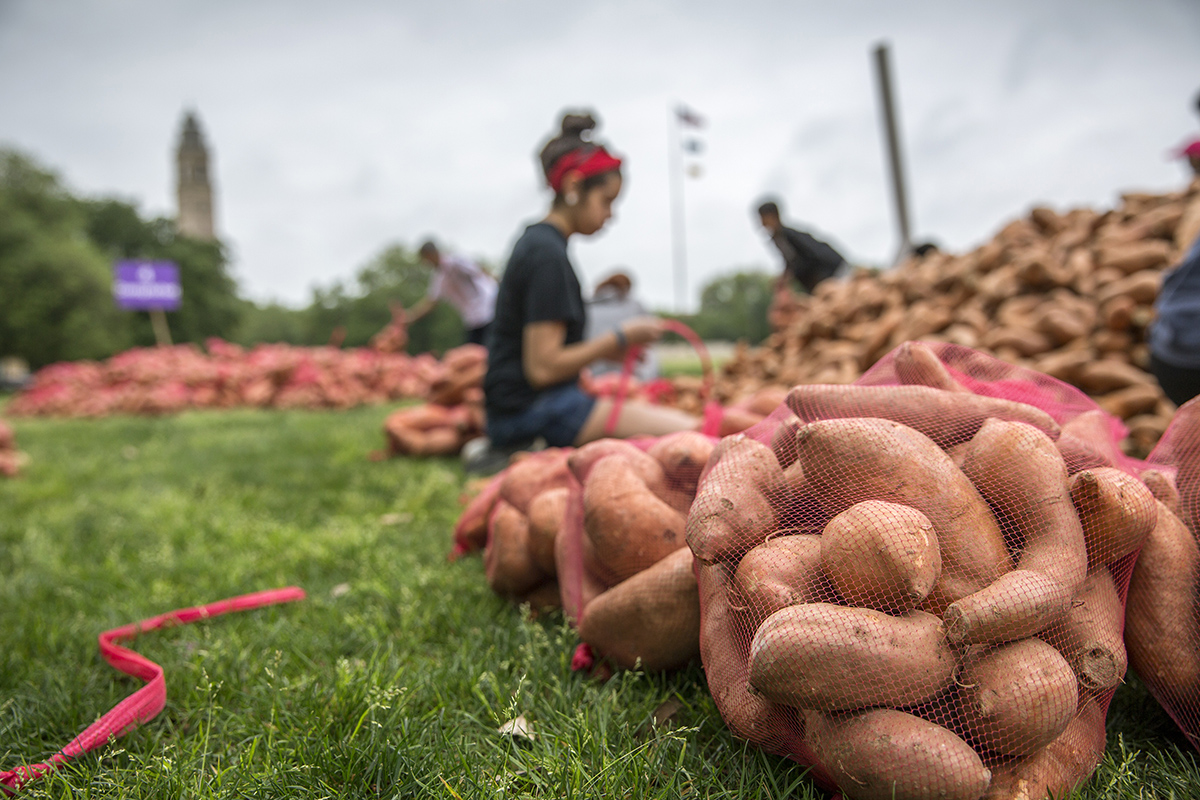
Sweet potatoes being bagged on the main LSU campus in Baton Rouge, Louisiana.
LSU
There has been some talk lately about the value of “ugly” produce that might have a hard time making it into the grocery stores. Nobody is calling sweet potatoes ugly, but few have more experience with crops that can be crooked, twisted, and pointy than sweet potato farmers. Seeing how irregular shapes in the field can make for irregular income for growers, LSU AgCenter sweet potato researcher Arthur Villordon and professor and sweet potato breeder Don Labonte are constantly trying to improve on current varieties. The Sweet Potato Research Station at 130 Sweet Potato Road in Chase, Louisiana—the only station of its kind in the U.S.—has developed 30 new varieties since the 1930s, and more are on the way, including a variety with purple flesh, another with bright red skin, and a third with increased nematode (soil pest) resistance.
LSU AgCenter-developed varieties dominate sweet potato fields in Louisiana (98%) and in several other states and nations in the world, including Australia (90%).
While some brag about being “big in Japan,” the LSU AgCenter’s sweet potato breeding
program can brag about being big in Australia. About 90% of all sweet potato varieties
grown down under were developed in Louisiana. Bellevue, a variety with well-known
nematode resistance, is especially popular there since it’s against the law to use
chemical controls. LSU AgCenter-developed varieties also dominate fields in Arkansas
and Mississippi as well as in several countries in Central America, including Guatemala,
Honduras, and Costa Rica. The most popular variety, Beauregard, looks a lot like a
newer release, Orleans, in that they both have orange flesh and rose-colored skin—the
way consumers often expect sweet potatoes to look. But only about a third of all sweet
potatoes grown in Louisiana are sold as-is in grocery stores and markets. Most are
destined for processing—canned or cut into sweet potato fries.
Villordon is trying to find practical things farmers can do to control the shape of
their sweet potatoes so they can get better prices for them once they go to processing.
“If you ever tried to cut fries out of a corkscrew-shaped potato, you can understand
why processors want sweet potatoes that look like big grapes,” Villordon said. “While
root length remains mysterious, we’ve found ways for growers to change the shape and
make it rounder by changing the phosphorus levels in the soil.”
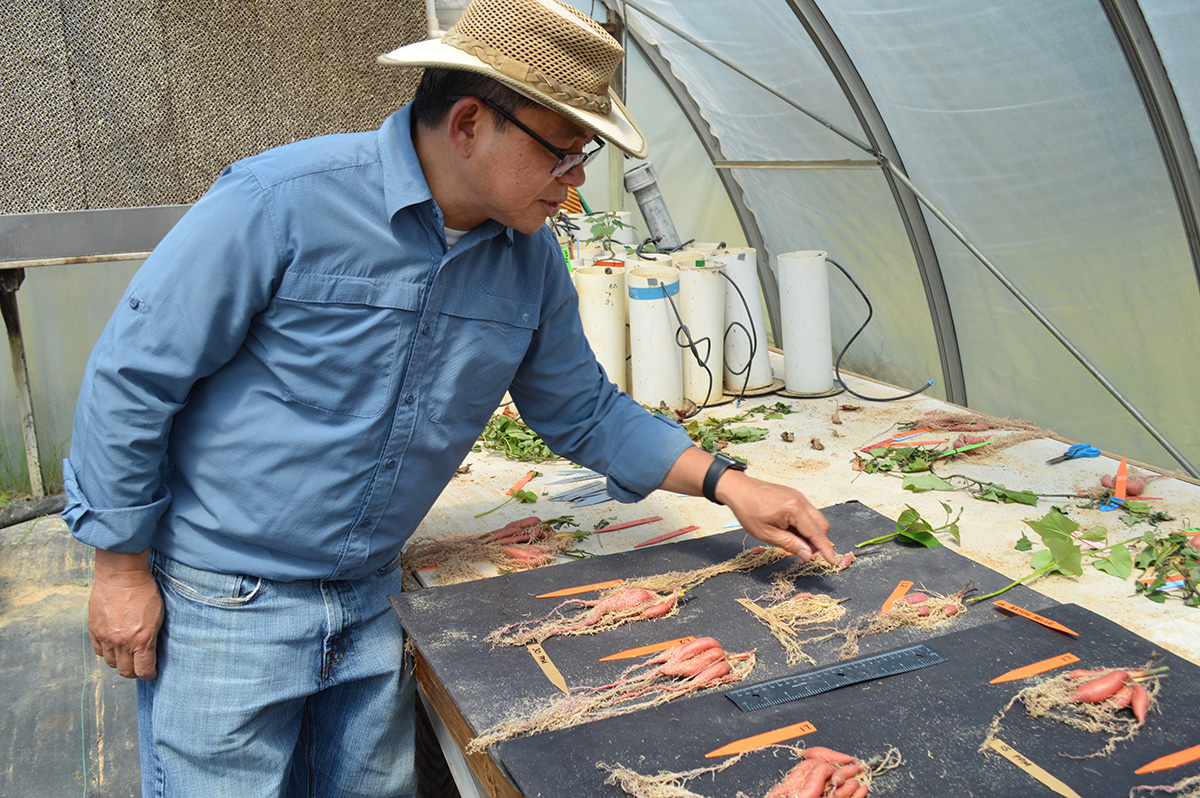
Sweet potato researcher Arthur Villordon. LSU AgCenter-developed varieties of sweet potato had a $94 million economic impact for Louisiana in 2019. The university has developed 30 varieties of sweet potato since the 1930s, tripled yields for farmers since 1970, and represent 98% of all sweet potatoes grown in Louisiana.
LSU AgCenter
His research has revealed that excessive phosphorus, a common fertilizer, isn’t only
bad for the environment and expensive for farmers, it can also hinder potato growth.
New varieties developed by the LSU AgCenter require less phosphorus per acre—about
90 instead of 120 pounds. Unlike nitrogen, phosphorus also builds up in the soil over
time and in order for the sweet potato plants to benefit, the fertilizer must be applied
right where they grow.
“We work with farmers on how to do best apply phosphorus,” Villordon said. “Instead
of broadcast application where the phosphorus goes everywhere, farmers can save money
by applying it only where’s it’s useful. This also protects our waterways.”
Villordon is also working with growers on finding a “sweet spot” in terms of management
cost by using precision agriculture techniques. By dividing their fields into grids,
farmers can send multiple soil samples to the lab ahead of planting to see what each
area needs in terms of fertilizer. While soil analysis can be expensive, growers save
by applying phosphorus more strategically and getting a bigger and more even yield
across their farm.
In large part due to LSU AgCenter research and development efforts, sweet potato yield
has tripled in Louisiana in the last fifty years.
“Sweet potato is an excellent and nutritious food that is easy to store and cook,”
Villordon said. “While my focus in research always has been on what will be the most
useful and practical for farmers, it’s nice to be reminded of how much people love
sweet potatoes. Before COVID-19, our local grocery store had several baskets full
of sweet potatoes, but as soon as the pandemic hit, they were all gone. People bought
them all. I had to bring sweet potatoes home from work.”
Read more:
Sweet, but Tough: Helping Farmers Grow Resilient, Shapely Sweet Potatoes
Elsa Hahne
LSU Office of Research & Economic Development
ehahne@lsu.edu